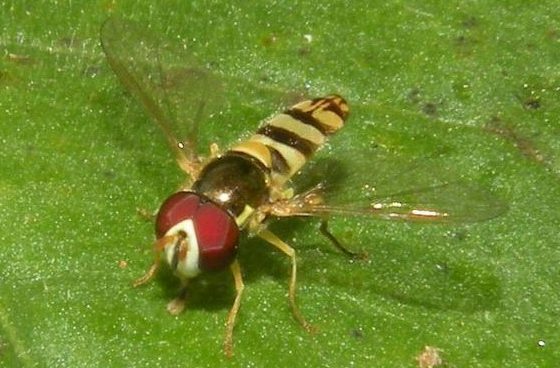
by Molly Jameson | Apr 28, 2022
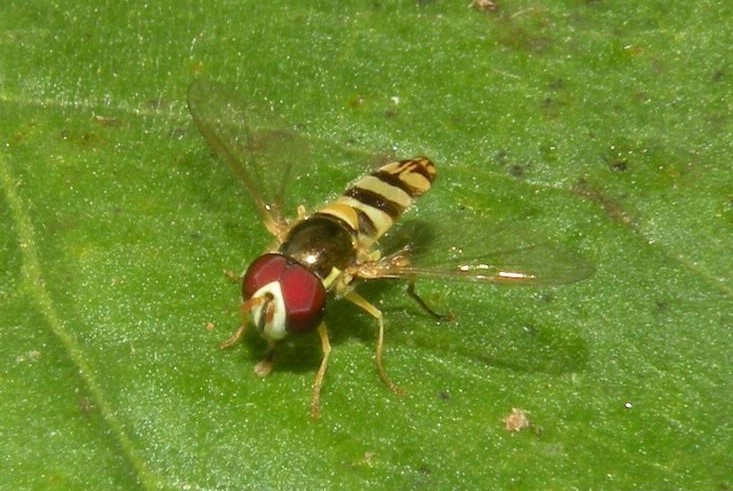
While we think of most flies as pests, garden flies, such as Allograpta obliqua species found in Florida, are excellent pollinators and predators of insects. Photo by Jessica Louque, Smithers Viscient, Bugwood.org.
While our sentiments toward flies usually involve fly swatters, believe it or not, not all flies are nuisance pests! Some types of flies can actually be quite helpful in the garden.
These garden flies are nothing like your typical pesky house fly. While house flies and garden flies are both insects in the order Diptera, they are not in the same insect family, which is the next classification down in Linnaean taxonomy.
The nectar-loving garden flies that specifically visit flowers are in the family Syrphidae and are known as Syrphid flies, hoverflies, or flower flies. Although not as well-known in the pollinating world, there are almost 900 species of flower flies in North America, and they can be very colorful and eye-catching in the garden.
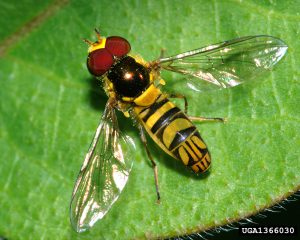
Allograpta obliqua flower fly adults are small and have bright yellow and black crossbands on their abdomens. Photo by Susan Ellis, Bugwood.org.
One of the most common flower flies in Florida is the species Allograpta obliqua. Members of this species, also called hoverflies, are often mistaken as fruit flies, and can therefore be perceived as harmful. But to the contrary, adults cross pollinate many flowers, and hoverfly larvae feed on predators, such as aphids that attack vegetables, fruit trees, cotton, ornamentals, and many wild plants. In fact, when there are numerous hoverfly larvae present, they can reduce aphid infestations by 70 to 100 percent!
Allograpta obliqua adults can be hard to spot, as they are a mere six-to-seven millimeters in length. Although small, they have distinct bright-yellow and black crossbands on their abdomen and become particularly abundant in the spring and summer here in the Florida Panhandle.
So, before you go swatting at any ole fly you see, remember that flower flies are our allies in the garden. Adults will aid in the pollination of our crops and landscape plants, and larvae will help defend our spring and summer veggies from the devastation of harmful insect attacks.
Learn more about Allograpta obliqua hoverfly species at the UF/IFAS Featured Creatures website (https://entnemdept.ufl.edu/creatures/beneficial/hover_fly.htm).
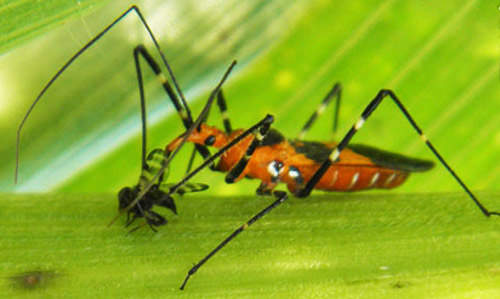
by Matthew Orwat | Apr 7, 2016
This spring, most garden plants are putting on lots of tender new growth. The lush foliage is like a free lunch to aphids, whiteflies, mealybugs and thrips. Before broad spectrum insecticides are used to control these pests, consider the impact on beneficial insects. Insecticides that don’t measurably harm predatory beneficial insects include insecticidal soaps and all season horticultural oils, which kill soft-bodied insect pests at application. Here are several common beneficial predatory and parasitic insects that help keep the pests at bay.
Assassin Bug Zelus longipes
Assassin bugs are predators of several leaf feeding and sap sucking insects including the fall army worm and the Asian citrus psyllid. They trap their prey by holding onto it with their forelegs and secreting enzymes into the prey to dissolve the interior tissue. Then they ingest the dissolved tissue.
Lady Bug or Lady Beetle
These insects most commonly feed on aphids, most insect eggs, whiteflies, small caterpillars, scale and mealybugs. They provide a measurable benefit to gardens since they are such generalized feeders. The Lady Beetle larva look substantially different from the adult stage.
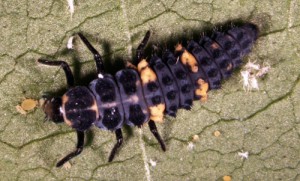
Third instar larvae of Hippodamia convergens. Photograph by Luis F. Aristizábal, University of Florida
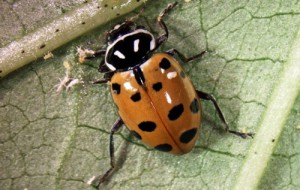
Newly emerged adult Hippodamia convergens showing typical body markings. Photograph by Luis F. Aristizábal, University of Florida.
Soldier Bug
A different but closely related species of the stink bug, this predator uses its piercing / sucking mouthparts to feed on larval beetles and caterpillars.
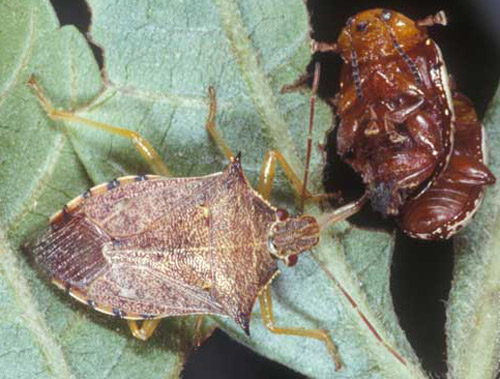
Dorsal view of an adult spined soldier bug, Podisus maculiventris (Say), feeding on a mating pair of sumac flea beetles, Blepharida rhois (Forster) (Coleoptera: Chrysomelidae). Photograph by Lyle J. Buss, University of Florida.
Lacewings
The green and brown lacewing is often found around aphid infestations. The larva is the major predator, they make the biggest dent on aphid populations. In addition to aphids, lacewings also feed on scale, mealybugs and several species of insect eggs.
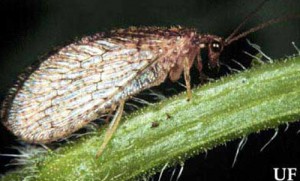
Adult brown lacewing (Neuroptera: Hemerobiidae). Photograph by University of Florida.
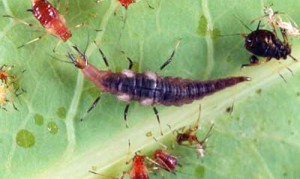
Larva of a brown lacewing (Neuroptera: Hemerobiidae) preparing to attack and feed on an aphid. The black-colored aphid to the right was probably parasitized by a wasp. Photograph by Lyle J. Buss, University of Florida.
Predatory Gall Midges
This aphid predator is easily overlooked because it is so small, and resembles the flower fly. They also feed on scale, thrips and mites.
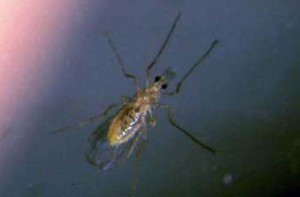
Adult of the predatory gall-midge, Feltiella acarisuga (Vallot). Photograph by David R. Gillespie, Agassiz.
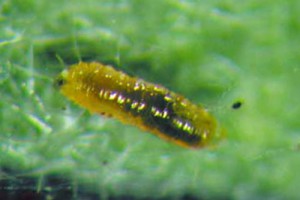
Larva of the predatory gall-midge, Feltiella acarisuga (Vallot). Photograph by Lance S. Osborne, University of Florida.
Flower Flies (Hover Flies)
Flower Flies actually resemble honeybees or bumblebees. People often run from them! The adult is an important pollinator for many crop species and feeds on nectar and aphid honeydew. This time it’s the larva which is predatory and is a voracious feeder of aphids. Large concentrations of larvae substantially reduce aphid populations in aphid infested gardens and fields.
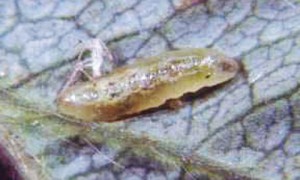
Larva of Allograpta obliqua (Say), a hover fly. Photograph by James F. Price, University of Florida.
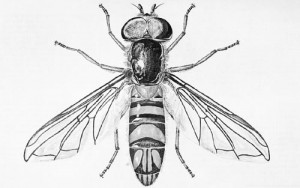
An adult male hover fly, Allograpta obliqua (Say). Graphic by Division of Plant Industry.
Parasitic Flies
There are many types of parasitic flies which parasitize a variety of insect pest species. They may inject their eggs into the host, or lay the egg on the surface of their host. Usually they are very small and not noticeable.
Parasitic Wasps
Most parasitic wasp species are tiny, fast and hard to notice. The average gardener is not aware of their rather plentiful existence. They are a common killer of grubs, caterpillars, whiteflies and aphids. They either insert their eggs into the organism or lay eggs on the surface of their host.
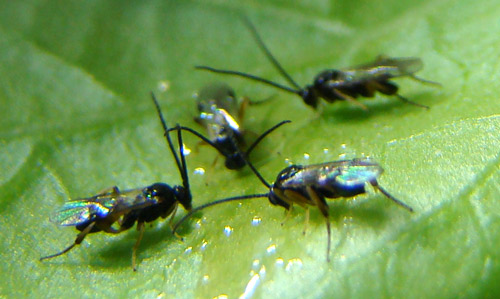
A group of adult Cotesia congregata (Say) wasps feeding on honey solution placed on the underside of a tomato leaf. Photograph by Justin Bredlau, Virginia Commonwealth University.
Big Eyed Bugs and Minute Pirate Bugs
While big eyed bugs and minute pirate bugs are not related, they perform similar functions in gardens and agricultural systems by feeding on chinch bug nymphs, psocids, leafhoppers, aphids, thrips, and mites. They are found in variety of ecosystems and do their job anonymously.
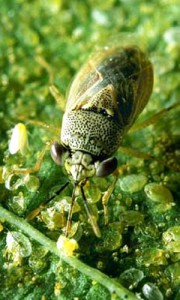
Adult bigeyed bug, Geocoris sp., feeding on a whitefly nymph. Photograph by Jack Dykinga, USDA
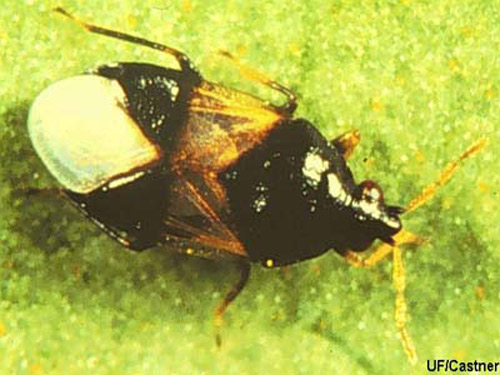
The minute pirate bugs are black with white markings. They prey on many small insects and eggs, including thrips. About 70 species exist in North America. Photograph by James Castner, University of Florida
References:
















